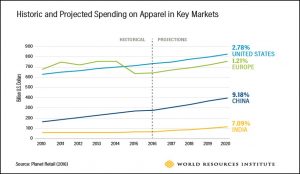The fashion industry is the world’s second largest industrial polluter, second only to oil. In fact, 20% of global production waste comes from the textile and apparel sectors.
Plus, the rise of fast fashion means that we’re throwing out our clothes at an alarming rate. The average consumer bought 60% more clothing in 2014 than in 2000, but kept each garment half as long. Another survey found that women in the UK only wore their clothes an average of 7 times before disposing of them. As a result, over 90 million items of clothing end up in landfills around the world.
And apparel spending worldwide is only projected to grow, intensifying the impacts of both production and post-consumer waste.
Why Isn’t Technology the Answer?
Many see textile recycling technology as a panacea to the world’s growing apparel waste. A handful of companies, such as Econyl, Evernu, Worn Again and HK Research Institute are developing mechanical or chemical processes to recycle textiles.
The allure of technology is understandable—it represents creativity, innovation and the future. These days, it’s seen as the answer to every problem. If it hasn’t already provided the solution, our unyielding faith in its potential leads us to believe that it will.
This may present a problem though —particularly when it comes to the fashion industry.
At this point, there are many limitations to textile recycling technologies such as:
- Unable to separate clothes with more than two fiber types
- Unable to recycle clothes with more than 5% elastane (elastic)
- Unable to ensure that the recycled natural fibers are long and strong enough to produce an entire garment out of
- Energy and/ or chemical intensive
As a result, it’d be naïve of us to expect that they’ll be able to process any significant amount of discarded textiles in the near future. It’ll be a while before textile recycling technology can catch up to the pace at which we’re currently throwing clothes away – if ever.
Extending Clothing Life Will Allow Technology to Catch Up
There’s immense value loss in disposing of clothes so frequently. A recent study conducted by Fibersort and the European Regional Development Fund found that approximately 64% of post-consumer textiles are rewearable, meaning that we’re throwing out clothes well before the end of their useful life. To give you a sense of the scale of the loss (and the size of the potential), less than 15% of the 15 million tons of used textile waste is recycled in the United States annually!
Even if textile recycling technologies were to be commercialized, that wouldn’t solve for the number of used garments lost to downcycling and landfills each year through inefficient collection
So what’s the answer? Purchasing fewer, higher quality clothes and wearing them longer.
As consumers, we have tremendous power to reverse these destructive trends of the fashion industry. According to the Waste & Resources Action Programme (WRAP), extending the life of clothing by an extra nine months of active use would reduce carbon, waste and water footprints by around 20-30% each and cut resource costs by 20%.
Clothes should not have a similar lifespan as the food and beverage industry. Small changes in our behavior can change that and allow textile recycling technology to eventually catch up.

